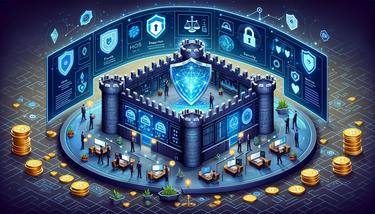Mining
Mining[1] in the context of blockchain[2] technology refers to the process of validating transactions and creating new blocks on the blockchain. It involves solving complex cryptographic puzzles to ensure the security and integrity of the blockchain network. Miners are rewarded with cryptocurrency[3] for their efforts.
How Mining Works
Mining requires significant computational power. Miners use specialized hardware to solve cryptographic puzzles. The first miner to solve the puzzle gets to add a new block to the blockchain and is rewarded with a specific amount of cryptocurrency, along with the transaction fees from the transactions included in the block.
The Role of Mining in Blockchain Security
Mining plays a crucial role in maintaining the security of blockchain networks. It prevents double-spending, ensures the immutability[4] of the blockchain, and distributes consensus across a decentralized network.
Challenges in Mining
Despite its importance, mining faces several challenges, including high energy consumption[5], centralization risks due to the concentration of mining power in a few hands, and diminishing rewards over time as part of the cryptocurrency’s issuance model.
Mining is a fundamental aspect of blockchain technology, facilitating transaction validation, network security, and the decentralized consensus mechanism. While it presents challenges, it remains an essential process for the functioning and integrity of blockchain networks.
Key Facts
- Mining involves solving complex cryptographic puzzles to validate transactions and create new blocks.
- Miners are rewarded with cryptocurrency and transaction fees.
- Mining ensures the security and integrity of blockchain networks.
Mining
Mining in the context of cryptocurrency is a fundamental process that not only facilitates the creation of new coins but also secures the network and processes transactions. This crucial mechanism underpins the functionality of many cryptocurrencies[6], most notably Bitcoin[7], and employs a decentralized approach to validating transactions and adding them to the blockchain ledger[8]. Understanding mining is essential for anyone interested in the technical and economic aspects of cryptocurrencies.
The Essence of Cryptocurrency Mining
Mining is the computational process that solves complex mathematical problems to verify transaction blocks. The first miner to solve the problem gets the right to add the new block to the blockchain and, in return, receives a reward in the form of newly minted coins and transaction fees. This incentivizes miners to contribute their computational power to the network, maintaining its security and integrity.
Proof of Work (PoW) Consensus Mechanism
At the heart of mining is the Proof of Work consensus mechanism. PoW requires miners to expend computational energy to solve cryptographic puzzles. The difficulty of these puzzles adjusts over time, ensuring that the addition of new blocks remains consistent despite fluctuations in the network’s total mining power. PoW not only deters malicious actors by making attacks costly but also underpins the decentralized and trustless nature of blockchain.
Mining Hardware and Technology
Mining technology has evolved from using standard computer processors to specialized hardware, including Graphics Processing Units (GPUs) and Application-Specific Integrated Circuits (ASICs). These advancements have significantly increased mining efficiency and speed but also raised barriers to entry due to the high cost of specialized equipment and the electricity required to power it.
Mining Pools and Their Role
As individual mining became less viable due to increasing difficulty and energy costs, miners started to form pools to combine their computational resources. By working together in a mining pool, miners increase their chances of solving puzzles and earning rewards, which are then distributed among pool members according to their contributed processing power. This collaboration makes mining more accessible but also centralizes power to some extent.
The Environmental Impact of Mining
One of the most contentious aspects of mining, especially PoW-based mining, is its environmental impact. The significant energy consumption required for mining, particularly for networks like Bitcoin, has led to concerns about its sustainability and carbon footprint. The search for greener alternatives and more energy-efficient consensus mechanisms[9] is ongoing within the cryptocurrency community.
The Future of Mining
The future of mining is likely to see further technological advancements, shifts towards more sustainable practices, and possibly the adoption of alternative consensus mechanisms like Proof of Stake (PoS), which requires less energy. The evolution of mining practices will play a crucial role in the scalability[10], security, and environmental impact of cryptocurrencies.
Mining is not just a process of creating new coins; it’s the backbone of cryptocurrency security and integrity. Despite its challenges, particularly regarding energy consumption and environmental impact, mining remains a critical component of the cryptocurrency ecosystem. Its future developments and innovations will significantly influence the direction and sustainability of cryptocurrencies.
- Mining — The process of validating new transactions on a blockchain network and adding them to the ledger.
- Blockchain — A decentralized digital ledger recording cryptocurrency transactions across multiple computers.
- Cryptocurrency — Digital or virtual currency secured by cryptography, facilitates secure, anonymous transactions.
- Immutability — The characteristic of blockchain technology that ensures once data is recorded, it cannot be altered or tampered with, providing a secure and tamper-evident record of transactions.
- Energy Consumption — The significant amount of electrical power required by blockchain networks, especially those using Proof of Work consensus mechanisms, raising concerns over their environmental impact due to high carbon emissions.
- Cryptocurrencies — Digital or virtual currencies that use cryptography for security and operate on a decentralized system, unlike traditional currencies.
- Bitcoin — The first and most well-known cryptocurrency, was introduced in 2009 by Satoshi Nakamoto, who developed Bitcoin.
- Ledger — A digital record of all cryptocurrency transactions, maintained across several computers in a distributed manner.
- Consensus Mechanisms — Processes used in blockchain networks to achieve necessary agreement on a single data value or a single state of the network among distributed processes or multi-agent systems, such as Proof of Work or Proof of Stake, ensuring all transactions are valid and preventing fraud.
- Scalability — The ability of a blockchain network to handle a large number of transactions quickly.


